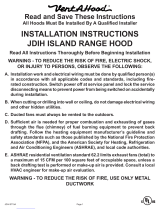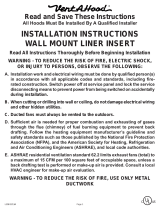Vent-a-Hood JPH454C2BLAS Installation guide
- Type
- Installation guide
Vent-a-Hood JPH454C2BLAS is a wall mount range hood tailored for optimum performance at a height of no more than 30" above the cooking surface. It comes with a Magic Lung® blower that provides the equivalent CFM of a much larger system while efficiently removing odors and contaminants. The hood's design allows for either vertical or horizontal ducting, providing flexibility in installation. It features E-Z Clean shields that can be easily removed for cleaning.
Vent-a-Hood JPH454C2BLAS is a wall mount range hood tailored for optimum performance at a height of no more than 30" above the cooking surface. It comes with a Magic Lung® blower that provides the equivalent CFM of a much larger system while efficiently removing odors and contaminants. The hood's design allows for either vertical or horizontal ducting, providing flexibility in installation. It features E-Z Clean shields that can be easily removed for cleaning.







-
 1
1
-
 2
2
-
 3
3
-
 4
4
-
 5
5
-
 6
6
-
 7
7
Vent-a-Hood JPH454C2BLAS Installation guide
- Type
- Installation guide
Vent-a-Hood JPH454C2BLAS is a wall mount range hood tailored for optimum performance at a height of no more than 30" above the cooking surface. It comes with a Magic Lung® blower that provides the equivalent CFM of a much larger system while efficiently removing odors and contaminants. The hood's design allows for either vertical or horizontal ducting, providing flexibility in installation. It features E-Z Clean shields that can be easily removed for cleaning.
Ask a question and I''ll find the answer in the document
Finding information in a document is now easier with AI
Related papers
-
Vent-a-Hood CLH9 User manual
-
Vent-a-Hood PRH18230BVSS User manual
-
Vent-a-Hood PRH18130SS Installation guide
-
Vent-a-Hood SLH6K30BL Installation guide
-
Vent-a-Hood ZTH236SS Installation Instructions (Adobe Acrobat Format)
-
Vent-a-Hood XRXH18 Installation guide
-
Vent-a-Hood PRXH18236SS Installation guide
-
Vent-a-Hood PRXH18236SS Installation guide
-
Vent-a-Hood ZTH236SS Installation guide
-
Vent-a-Hood XRH9 User manual
Other documents
-
 VentAHood JDIH ISLAND Installation Instructions Manual
VentAHood JDIH ISLAND Installation Instructions Manual
-
Lambro L378 Installation guide
-
 VentAHood VP543 Installation Instructions Manual
VentAHood VP543 Installation Instructions Manual
-
Lambro L377 Installation guide
-
Ada B200S Owner's manual
-
Paragon Outdoor PRH4-1220WT User manual
-
Paragon Outdoor PR5-12LVGRY User manual
-
Hestan KVP54 Installation guide
-
Hestan KVP48 Installation guide
-
Hestan KVC48 Installation guide








